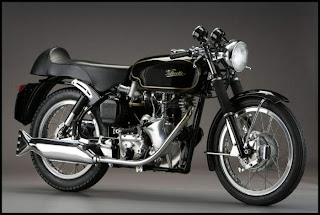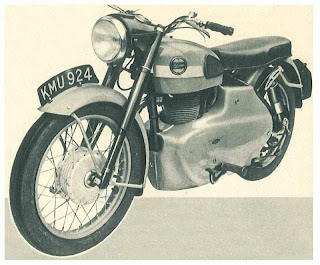In 1965 the well proven Venom was improved by Velocette designer Bertie Goodman with a special race kit complete with radically revised cylinder head, an Amal Grand Prix carburetor and reworked cam followers. The following year this went into production as the Velocette Thruxton. Also known as the Venom Thruxton, this aimed to fill the gap left by the demise of the BSA Gold Star and was named after the Thruxton Circuit race track on a former wartime airfield in Hampshire. The Velocette Thruxton was a true racer, with a full race specification cylinder head that was gas flowed by hand to accommodate extra-large valves and a downdraught inlet port. The Amal carburetor was so large it required a distinctive cut away in the bottom of the fuel tank and race cams boosted performance to up to 120mph.[7] As well as the traditional black with gold lining finish, the Velocette Thruxton was also produced with an unusual blue frame, forks and seat and silver petrol tank with gold lining. In 1969 the Lucas Magneto was phased out an replaced by coil ignition. A total of 1108 Thruxtons were built but although it had more power than the Venom the Thruxton couldn't save Velocette and the company was wound up in 1968, with remaining stock sold until mid 1970. The Thruxton has gone on to become one of the most sought after Velocette motorcycles today, however, and many private owners convert standard Venoms to the more valuable Thruxton specification
Road Test
Chromium-plated trimmings are all very well, but they never add performance. With this in mind, Velocettes produce their Venom Special with most parts, such as the fuel tank, wheel rims and mudguards, which are normally plated, finished in enamel. Only mechanical difference is the use of a "waisted" rear hub instead of the Venom full-width type. The glass-fibre engine enclosure panels are retained.
Add the smooth charm of a beefy single, superb roadholding allied to exceptionally powerful brakes and the balance sheet shows an extremely desirable hogbus.
Likely to catch out first-timers unless the manufacturers' recommended drill was followed, cold starting usually required only one or two hefty swings on the pedal. On occasion, though, after a cold night in the open, the model required half a dozen swings before responding.
A single prod always produced results when the engine was warm.
BEEFY PUNCH
Pleasantly quiet mechanically, the engine produced beefy punch that encouraged early changing up—a bonus in built-up areas in view of the pleasantly sharp, but nevertheless loud, exhaust note. On the other hand, no one could complain of noise when the model was chuffing along at 30 mph in top.
Only low-speed indication of a sporty valve timing was erratic tick-over. To be reliable, idling had to be slightly fast and this sometimes caused noisy engagement of bottom gear.
Given its head on the open road, the Venom galloped to 80-plus with the rider sitting upright, or nudged 90 on downgrades. Half throttle gave a genuine 70 to 73 mph which could be maintained indefinitely without fuss or vibration and there was still ample performance left to cope with steep gradients in top gear.
The speedometer was commendably accurate, being no more than 1 mph fast. Super-grade fuel was used and prevented pinking unless the engine was abused.
Only indication of hard driving at the end of a long run was some oil drops from beneath the left-hand side panel where oil had been flung off the rear chain. A minor leak also developed during the test from the inlet side of the rocker box. Initially, the bottom gear of 11.24 to 1 seemed too high, but the illusion was soon dispelled when coping with the one-in-three test hill at MIRA. Ideally spaced, the other ratios matched engine characteristics perfectly. On the open road, second was usually held to 50 mph and third to 65 mph.
Light in operation, the clutch engaged the drive progressively, but after repeated use in dense city traffic it showed a tendency to drag. For this reason neutral was sometimes difficult to locate from bottom or second when at standstill.
Otherwise pleasantly smooth, the transmission produced a tremor, felt mainly through the left footrest and handlebar, when the engine was pulling very hard—such as on climbing a steep hill or restarting on a gradient.
Seat, footrests and handlebar positions gave a relaxed riding position up to 70 mph or so; then tall riders would have welcomed more forward lean to counteract wind pressure. A seat with deeper padding would have made long trips more comfortable.
With one exception, all controls were well positioned and light in operation. Exception was the combined horn button and dipswitch: this could not be operated without removing the left hand from the bar.
Race breeding showed on every bend through which the Venom swept. Light, utterly positive at all times—on all normal road surfaces, the steering was exemplary—sheer joy. Roadholding, too, was superb.
Well damped, both front and rear suspensions ironed out road shocks without pitching or weaving; even on the sharpest bumps, the suspension refused to bottom. The rear struts are adjustable for load and were normally set in the midway position for solo use; moving the units to the rear increases stiffness for passenger carrying. In short, the Venom Special was right in the top bracket for handling and a thoroughly reassuring model to ride under all conditions.
Among the most powerful on any big machine, the brakes lived up to their reputation—as the stopping distance shown in the performance panel indicates. They were equally as effective from maximum speed—smooth, progressively powerful and easily controllable. Throughout, the rear stopper squealed on hard application. Both brakes remained dry in wet weather.
For a machine of the Venom's performance, a headlight giving more range and spread would be an improvement. So would a louder horn.
Over the 1,200-mile test period, the model used a half pint of oil. Maintenance required was to adjust both chains once—a task hampered by the shrouding of the gearbox mounting front bolt by the clutch-cable stop.
Although it included a praiseworthy number of special tools, the kit omitted a spanner for the rear-wheel spindle nut.
Held in position by six screws, the glass-fibre side panels are easily detachable and enhance the appearance of the machine. A wipe with a damp cloth keeps them shiny.
Finished in blue-grey, the Venom Special must have a strong appeal to the rider who prefers to do without the glitter and be handsomely in pocket. He will own a machine of character, a rare quality in this mass-production age.
SPECIFICATIONS
ENGINE: Velocette 499 cc (86x86 mm) overhead-valve single-cylinder with caged-roller big-end bearing. Crankshaft supported in two taper-roller bearings. Aluminium-alloy cylinder head; light-alloy pushrods and hairpin valve springs. Compression ratio, 8 to 1. Dry-sump lubrication; oil-tank capacity, 4 pints.
CARBURETTOR: Amal Monobloc; air slide operated by handlebar lever.
IGNITION and LIGHTING: Lucas magneto with auto-advance. Belt-driven Miller 36-watt dynamo. Exide 6-volt, 12-amp-hour battery. Miller Tin-diameter headlamp with pre-focus light unit and 30/24-watt main bulb.
TRANSMISSION: Velocette four-speed gear box with positive-stop foot control. Gear ratios: bottom, 11.24 to 1; second, 7.78 to 1; third, 5.9 to 1; top, 4.89 to 1. Multi-plate clutch with fabric inserts. Primary chain, 1/2x0.305in in pressed-steel, oil-bath case. Rear chain with guard over top run. Engine rpm at 30 mph in top gear, 1,900.
FUEL CAPACITY: 3 gallons.
TYRES: Dunlop Gold Seal 3.25x19in ; front ribbed, rear K70 studded.
BRAKES: Front 71/2x11/2in; rear 7x1in. Finger adjuster for rear brake.
SUSPENSION: Velocette telescopic front fork with hydraulic damping. Pivoted rear fork controlled by Woodhead-Monroe spring-and-hydraulic units with adjustment for loading.
DIMENSIONS: Wheelbase, 5441n. Ground clearance, 51/2in. Seat height, 31in. All unladen.
WEIGHT: 378 lb fully equipped, with full oil tank and approximately one gallon of petrol.
PRICE: £269 14s (including British purchase tax). ROAD TAX: £4 10s a year; £1 13s for four months. MAKERS: Vetoes, Ltd, York Road, Hall Green, Birmingham, 28.
DESCRIPTION: Motor Cycle, 26 September 1963.
PERFORMANCE DATA
(Obtained at the Motor Industry Research Association's proving ground at Lindley, Leicestershire.) MEAN MAXIMUM SPEED: Bottom, 45 mph.; second, 65 mph"; third, 85 mph"; top, 93 mph. • Valve /loot occurring.
HIGHEST ONE-WAY SPEED: 95 mph (conditions: still air, 13-stone rider wearing two-piece suit and overboots).
PETROL CONSUMPTION: At 30 mph, 89 mpg; at 40 mph, 79 mpg; at 50 mph, 68 mpg; at 60 mph, 52 mpg.
BRAKING: From 30 mph to rest, 30ft 6in (surface, dry tarmac).
TURNING CIRCLE: 16ft.
MINIMUM NON-SNATCH SPEED: 19 mph in top gear.
WEIGHT PER CC: 0 75 lb.












No comments:
Post a Comment